I’ve never really understood diaspora angst. For many Asian Americans, it often seems to manifest as a kind of self-orientalization—a misremembered longing for the farness and otherness of the motherland, an exaggerated distance in geography and history alike. Here (the West) is treated as a contemporary and multicultural capitalist hellscape; there (the East) is ancient, nostalgic, and culturally pure. It reminds me of my Chinese relatives’ confused reaction to visiting American “Chinatowns.” These urban neighborhoods, with their pagoda-style roofs and gaudy red facades, look nothing like the China of the 21st century. They are reifications of exotified aesthetics from centuries ago, and in the years since, look less and less like their inspiration.1
But I find it impossible to feel nostalgia for a country that looks so radically different with every visit. My Shanghainese relatives have stayed mostly put—my mom’s family in Hongkou, near the central Huangpu river, and my dad’s side in the northern suburbs of Baoshan—but the urban landscape around them shifts with every year.
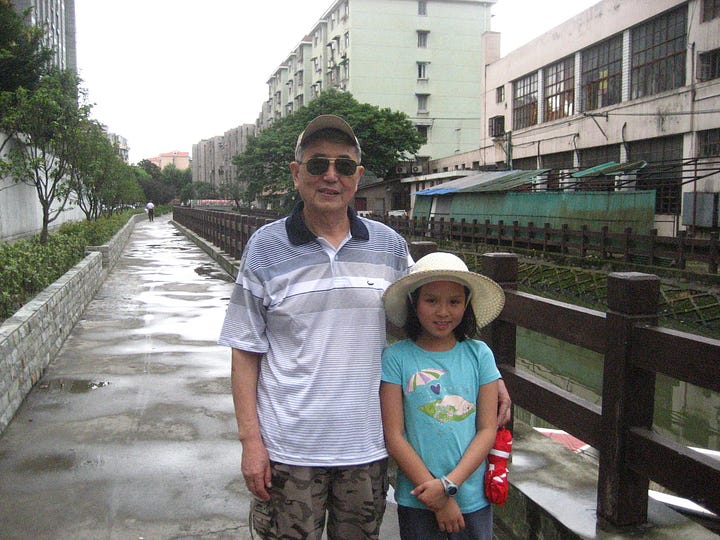
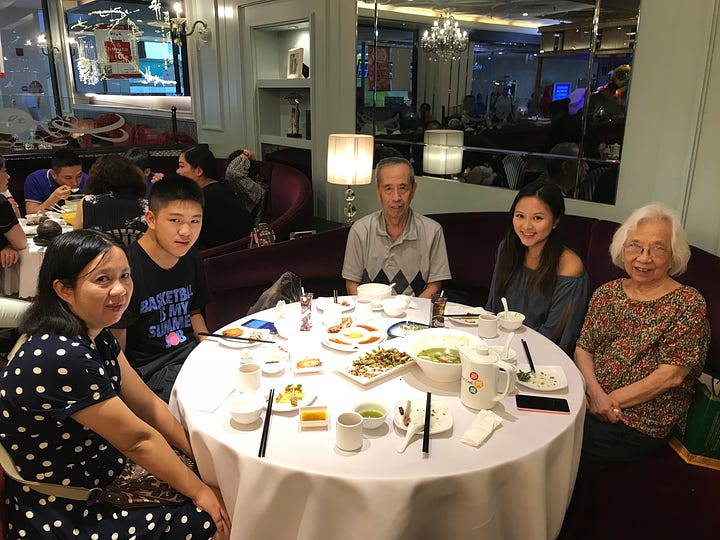
The Shanghai of my early childhood is filled with crowds and dirt. I remember the stench of trash rotting in the summer and the informal streetside markets selling produce and plastic goods in front of ramshackle apartments. In one standout memory, a middle-aged woman carts plastic bags of chicken carcasses across the street, dripping blood onto the hot asphalt. Doves cried out from cramped cages; scrawny stray cats roamed the streets. I was terrified of squat toilets where you had to bring your own paper, and how you had to push your way into every queue. Everything was gray.
I recently went to China for the first time in nearly six years. Like many other American-born Chinese, I grew up visiting every couple summers to see extended family, gorge myself on food, and practice my ever-deteriorating Mandarin. However, full-time work and the pandemic have extended the gap. To provide context for the rest of this reflection—and avoid claiming “blunt-force ethnic credibility”—I’ll describe my relation to China as both familiar and touristic. My parents were both born in Shanghai, and my extended family lives there too. But I’ve never stayed for more than a couple months at a time, or spent much time outside of Shanghai (and a summer in Taipei, Taiwan). I also can’t really read or write—I just speak enough to get around.2
As we pulled into my grandparents’ neighborhood, the first thing I noticed was the flowers. The Hongkou riverside, recently rebranded as the up-and-coming North Bund, now features a comfortable jogging route and immaculately manicured landscaping. There are artfully shaped public benches (the architecture here is not hostile), glass-walled wanghong3 cafes, and oblong mirror-ball installations reminiscent of tiny Chicago beans. At the local municipal park, seniors practiced tai chi and choir songs in blooming gardens. Even the stray cats looked clean. On the multi-lane Dongchangzhi Road, construction crews worked from 6am in the morning until 10pm at night. Their trucks, hulking eight-wheelers, overflowed with bushes—as if they’d carted an entire patch of forest into the megacity.

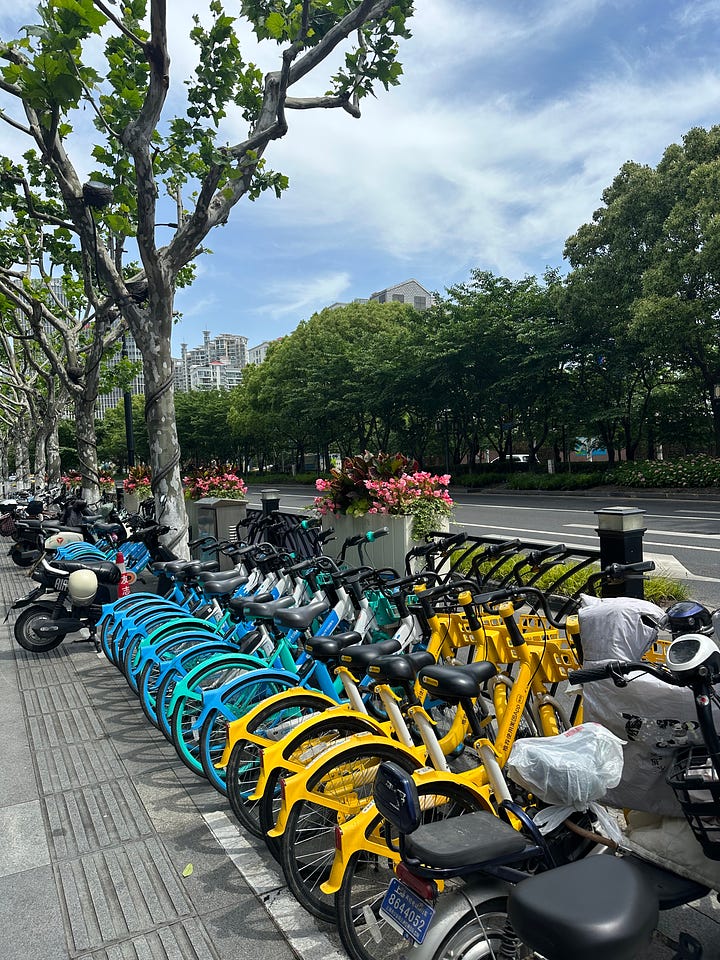
When I looked up the phenomenon later, I learned that Shanghai aims to become a “city of gardens” by 2025, increasing the number of gardens to 1,000 by 2025 and 2,000 by 2035.4 One city horticulturist explained that they “plant and maintain over 500,000 flowers of 100 species in some 5,000 street-side flower boxes,” and try to “change the floral scenes every 500 meters along a single road to avoid aesthetic fatigue.” They swap out the plants a whopping seven times a year. As a pedestrian observer, it seemed like the gardening crews were back to dig and replant as soon as they got their first whiff of a wilt.
Shanghai has also become a city of malls. Clothes and jewelry, yes—but also restaurants, groceries, car dealers, movie theaters, arcades, hair salons, sport courts, and pet shops—all clustered into gigantic malls. There are malls for every class strata between the 50th and 99.9 percent. The highest density of coffeeshops in the world; the fanciest escalators and elevators I’ve ever seen. It’s not uncommon for these malls to tower over six stories in height, or to be located across from three other malls, with skybridges facilitating the smooth flow of shoppers high above the traffic below. I found the malls very convenient. A cold drink and clean restroom were never more than a block away.
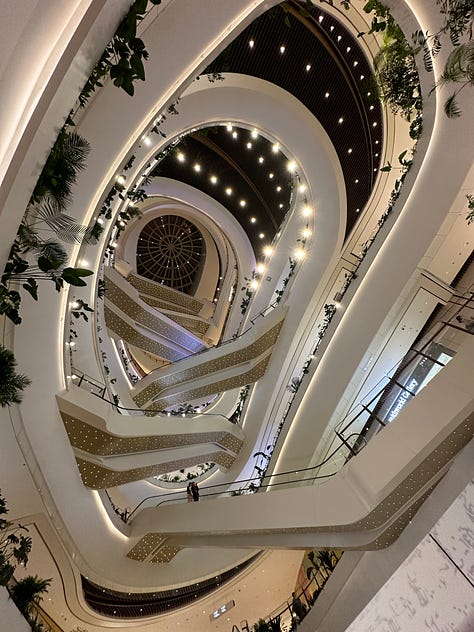

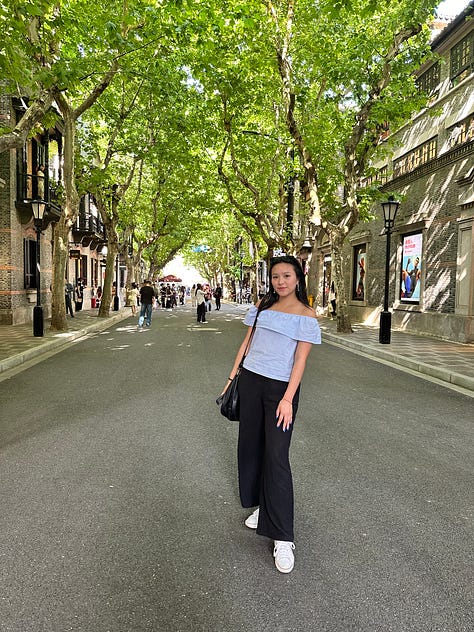
I was surprised by how recognizable the street fashion trends were—nearly identical to those in the States, except the Shanghainese went harder and better. Women wore striped cotton shirts, cozy button-down cardigans, and plenty of mesh. I saw pop-ups showcasing Stanley Cups and mall-side pickleball courts. In trendy areas like Huaihai Road, intimidatingly stylish young couples lined up around the block to enter perfume stores that could pass for modern art exhibits. No matter how nice I tried to look, I felt like the worst-dressed person in every room. Apparently this anxiety is a common one. In San Francisco, my friend Stone explained that this is referred to as chaoren kongju zheng on Chinese social media—the phobia of fashionable people.
Technology knits the city together. In China, bits and atoms work hand in hand. I paid 6 yuan for my morning jianbing by scanning a QR code pasted outside the food stall, and tapped my phone at the subway gates to enter and leave. Using different WeChat mini-programs, you can call a taxi, refill your metrocard, or use one of three different city bike-shares.5 Don’t bother setting up a separate payment method or carrying a physical wallet—your WeChat data automatically shows up in the integrated apps. And in case the ubiquitous malls and transit options aren’t convenient enough, the streets are filled with a scooter army of gig workers racing to fill orders on Meituan and Eleme. A relative in the suburbs wanted to gift us a box of tea, so she spent 18 yuan—less than three U.S. dollars—to have it picked up from her apartment and delivered to ours. It came in about forty-five minutes.6 As one American-born Shanghai resident told me over dinner, “Shanghai is the best place in the world to be a consumer.”
Shortly after returning from Shanghai last year, my parents’ Seattle-area home was broken into and burglarized. Our windows were shattered, every room overturned. The thieves tore down family pictures, flipped drawers onto floors, and even took cheap costume jewelry from my childhood bedroom. Of course, every cent of cash was gone.
The experience was a huge shock. We lived on a suburban street so quiet that we didn’t even get trick-or-treaters on Halloween, so no one expected this kind of crime. When relaying the story, my mom remarked that she now felt much safer in China than in the United States.
I also couldn't help making the comparison. In China, my chest tightened whenever we left bags unattended in a car. I didn’t need to worry, but it was hard to forget that break-ins are only normal in the Bay. In contrast to Shanghai’s shining empire of malls, the lone mall in downtown San Francisco lies half-empty, with more stores closing down every month. BART often comes at a paltry 30 minute cadence, and when it does arrive, you realize that the trains also serve as de facto shelters for the city’s unhoused and unwell. I am sympathetic to these problems—which I attribute to local policy and economics rather than individual misbehavior. But the longer I spent in Shanghai, the more my inner monologue sounded like a tech Twitter YIMBY: Why can’t America govern? Why can’t we build?7
This narrative isn’t lost on the Chinese, either. After a weekend out in Shanghai, my friends and I spent a day in nearby Zhejiang Province touring a manufacturer of small aircraft.
Wanfeng Aviation is located in a Chinese company town, where employees work and live on a single campus. In addition to the standard offices, factories, and dormitories, the town features a full museum showcasing the company’s history, a replica of the White House (“but bigger”) for the headquarters, and a small airport where we got to fly one of their trademark four-seater planes. We toured a mock air traffic control room, passed through hallways of framed photos with government officials, and watched a mini-documentary-cum-advertisement about Wanfeng’s storied achievements, featuring glamor shots of military pilot training and a heavy dose of Adobe After Effects. At lunch, we shared a bottle of the region’s famous huangjiu8 around a large round table with a plastic airplane centerpiece. We even took a loop around the factory floor—the only segment with “no photos allowed.” Despite the artifice, I was impressed.
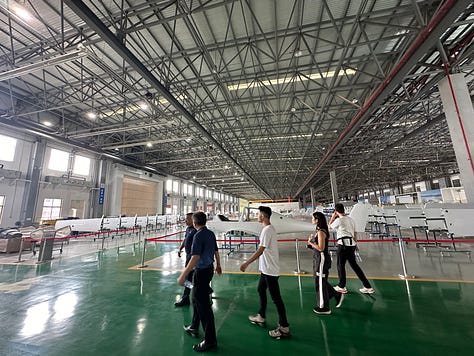
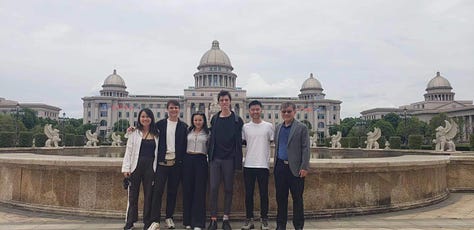

Chairman Liu Jianping, who led our tour, is proud, generous, and fiercely energetic—the absolute avatar of a Chinese businessman. He previously served as chairman of Shenzhen, Dalian, and Qingdao Airlines before pivoting to airplane manufacturing. He’s known as a capable organizational leader: in the documentary, we learned that all Wanfeng managers must pass military-style bootcamp training as part of their onboarding.
As we stood in front of the not-White-House, Liu told us about the rapid growth of his company: the factory started in 2014, shipped its first planes in 2015, and was profitable by 2018. “Ten years ago, this city was just a mountain. Now look at what it’s become!” Then, facing us Westerners, he adds: “In China, everyone works together to progress fast. Not like in America, where individuals just do whatever they want. That’s why we have high-speed rail and you don’t.”9
We laugh. I suppose he isn’t wrong.
As an American traveling in Shanghai, it’s easy to be swept up in all the abundance. Unlike in Silicon Valley, where technological advances feel confined to the cloud, Shanghai is a place where progress is tangible. It is baked into the fabric of everyday life, for every type of person. I’ve heard it theorized that this is why Chinese people seem less fearful of new technologies—thus far, they’ve experienced innovation alongside material improvements. Even class divisions do not appear so rigid, since so many ordinary people have recently ridden the wave from poverty to privilege. But as a visitor, you have to be careful not to mistake increased spending power for enjoyment of a place. To really live in a city is not the same as consuming it.
For instance, I mentioned to a Chinese-born friend that I was impressed with the pace of cultural change in China. Nowadays, I rarely see litter, fare-jumping, or cutting in lines. Restaurant waiters no longer ignored you; rather, they all seemed extraordinarily attentive and kind—even without the expectation of tipping. I marveled at how civil Chinese society had become in a few short years; I was aware that they could build infrastructure, but new habits seem far harder to instill. My friend’s reaction was mixed. She agreed with my observations, but suspected this had more to do with pervasive social monitoring and CCTV. “There’s less wiggle room now.”
I also met a few writers in Shanghai, via Substack10 and through mutual friends. While the bulk of our conversations focused on other topics, it became clear that China is an increasingly hostile place to do creative and intellectual work. Xi has been escalating press censorship, in both traditional and independent venues.11 Many writers have left the country, or switched to heads-down corporate jobs. In analyst Dan Wang’s 2023 letter, he laments how much China’s cultural production lags its population size and economic performance. He writes: “The party’s strangling of free expression has rendered China into a pitiful underperformer relative to Japan and South Korea in the creation of cultural products. What are the great Chinese creations of the last 20 years, aside from a science fiction trilogy published before Xi took office, a short-video app that doesn’t display Chinese content overseas, and a video game that looks as if it’s thoroughly Japanese?”12
The same anxious air of censorship and uncertainty also clouds the Chinese startup scene. In recent years, Xi’s “Common Prosperity” initiative has cracked down on afterschool tutoring, stock trading, consumer internet companies, billionaires, video games, crypto mining, stan culture, and other supposedly socially destructive industries. Most notoriously, the government seemingly “disappeared” Alibaba founder Jack Ma after he criticized financial regulators at a conference in Shanghai. The overzealous—and middlingly effective—regulatory regime has placed entrepreneurs in a state of precarity not unlike the migrant workers toiling to make their products.
But the best window into other sides of China lay in Yunnan, a rural province in China’s southwest. The region is a top destination for domestic tourists. It’s affordable, naturally beautiful, and culturally diverse. Yunnan makes up only 4% of China’s land, but contains around 42% and 73% of its animal and plant species respectively, and 25 of China’s 56 recognized ethnic minority groups.
Our Yunnan tour guide goes by the name Bean. He’s a thoughtful and soft-spoken 28-year-old, who was born in Mile City, Yunnan, and now lives in Dali. On the drive from the airport, I learned that Bean majored in Burmese at Peking University (known to most ABCs as the “Harvard of China”), was disillusioned by Beijing’s intense work culture, then spent two years as a Buddhist monk in Burma before returning to Yunnan. These days, his primary occupation is teaching Chinese middle schoolers about local plants. Bean wears glasses, is part of the Yi ethnic group, and recently adopted a puppy he named after a mushroom. He is currently reading a book about ferns.
As Bean drove us to lunch, he pointed out Lake Erhai (“a lake so big they call it hai, like a sea”), Cangshan Mountain (which we planned to hike that afternoon), and the Dali neighborhoods, which curve around the lake. We asked Bean about the half-built apartment buildings that punctured the skyline, and he explained that construction had been paused for several years. Apparently, when Xi visited, he liked Lake Erhai so much that he halted all nearby development until it got cleaned up.
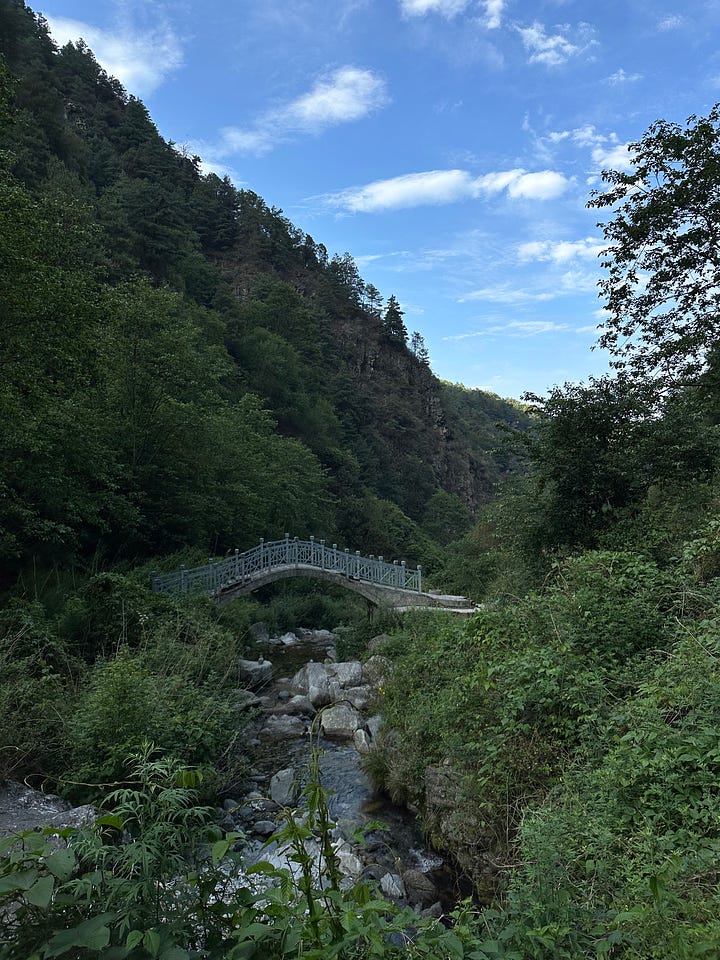
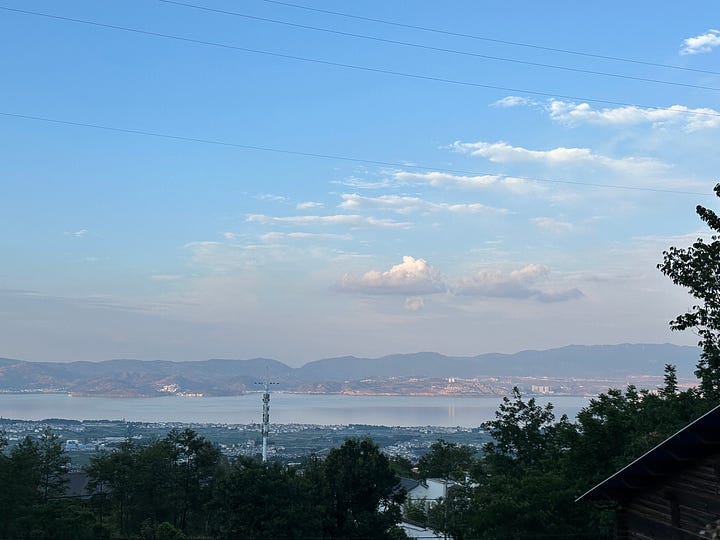
Cangshan Mountain reminded me of hiking in the Pacific Northwest. The trees, streams, ferns, and even the rhododendrons all felt strangely familiar (although the colorful pheasants did not). As we trekked down, Bean gestured at the surrounding pines. “These trees are actually very young. They were all planted within the last 50 years.”
For some reason, I had assumed that all forests are inherently ancient. But these were younger than my parents—and moreover, someone put them there, on purpose. Bean explained that the Cangshan Preserve was a conscious reforestation of land that was razed during the Great Leap Forward. At one point, this trail might have been the location of a failed steel furnace.
My friend Brian asked Bean what most people do in Dali. “Tangping,” Bean chuckles. “They do nothing.”
Tangping is a Chinese neologism that literally means “to lie flat,” as on a couch or a bed, scrolling TikTok on your phone. But its popular meaning is more symbolic. To tangping is to give up on the intense work culture of modern China, where the hours are long and competition is fierce. The climb to prosperity, paved by slowing growth and sky-high housing prices, seems far more strenuous—and far less certain—than it was when Reform and Opening began. Think “quiet quitting” on steroids: to tangping, you might quit your college and your job, or work very little. You won’t get married; you won’t buy a house. You might move away from the first-tier cities like Beijing and Shanghai, and instead to somewhere like Dali, where it’s viable to live on a couple hundred dollars a month.
It’s true: Dali is nothing like Shanghai. Nobody here is doing 996, the notorious corporate schedule of “9am to 9pm, 6 days a week.” My friend Alex, a software engineer who did undergrad in Shanghai, asked Bean repeatedly what people did with their spare time (answer: “gossip”); he couldn’t fathom their empty schedules. Many Dali residents are digital nomads, college dropouts, or white-collar burnouts. They instead run small businesses teaching art, opening inns, or reading tarot for tourists on the street. Instead of malls, Dali is dotted by small farms where locals grow rice, corn, garlic, and a wide range of local vegetables. Roosters crow loudly. Marijuana use is very illegal in China, but at the bars here, people are happy to share their weed.
Given the lush landscape, I should’ve expected the food to be as delicious as it was. I had worried about being a pescatarian in a landlocked province, but the local cuisines are rich with wild mountain plants, delicately cooked flowers, and mushrooms (e.g. the prized matsutake) more tender than any I’ve tasted before. The predominant flavors are spicy and tangy and herbaceous and fresh. Some dishes were more reminiscent of Thai or Vietnamese food than what I previously knew as “Chinese.”13
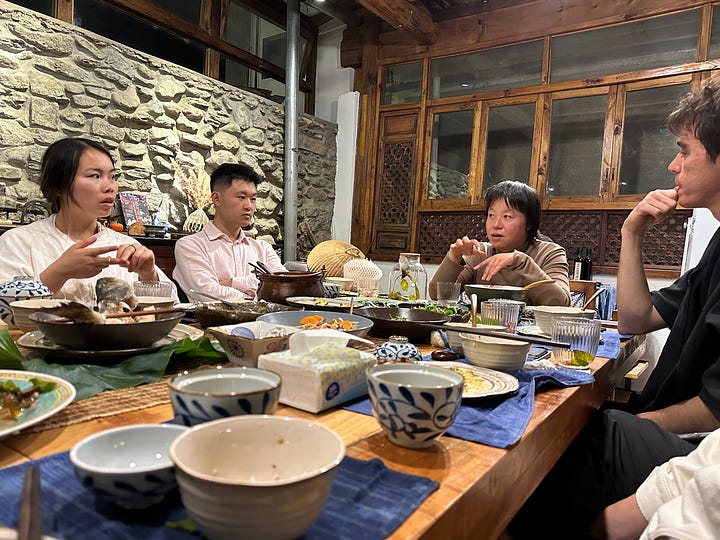
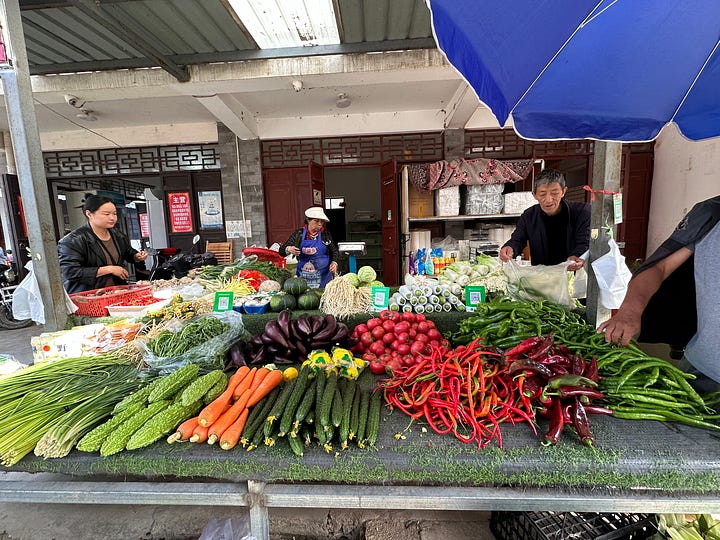
For dinner on our first night, we visited the home of a chef who left Shanghai, her hometown, to rebuild in Dali. “People have no lives in Shanghai,” Chef Mo told us. “Here, I can work hard and play hard.” Her food combined local ingredients with international culinary techniques; for our feast, we dug into bitter green salads with flower buds and feta, baguette slices topped with vegetarian pate, and a milky dessert soup with healing buqi properties. We were lucky to catch her—Mo met Bean at a party just two days before, and moved an appointment to make room for us. In addition to cooking, she teaches incense-making, studies traditional Chinese medicine from the local grandmas, and practices a form of Tibetan Buddhism. Her spoken Mandarin was slow and clear, and her vibe impeccably zen. It was a very memorable meal.
I was also enchanted by the architecture in Dali. Bai-style buildings have white walls and elegant gray roofs with upturned eaves. Their exteriors are decorated with calligraphy, or traditional paintings of birds and plants. It seemed like every apartment featured big windows, terraces, and open-air courtyards; and front doors always seemed to be open (even when nobody was home). The easy inside-outside flow made the whole city feel like a communal space.
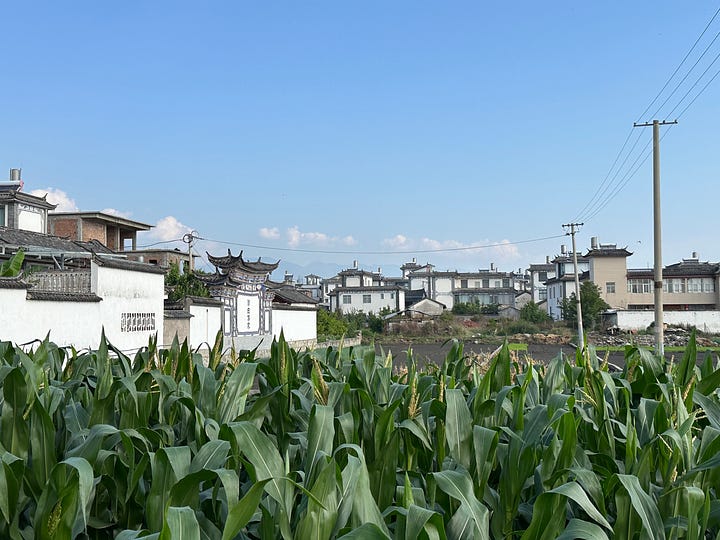
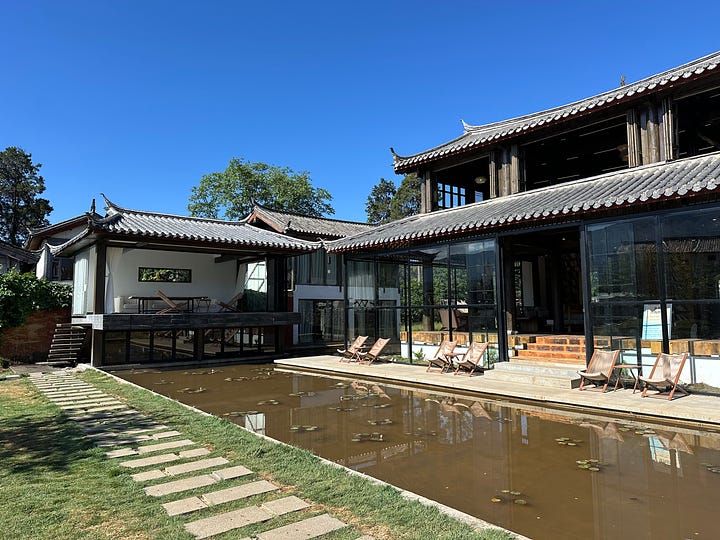
Dali is often dubbed “Dali-fornia” for its pleasant weather, laid-back energy, and green landscape—plus a sprinkling of counterculture and hipster woo. I totally felt it. By the end of our two days there, my friend Saffron and I had already begun daydreaming about coming back to recreate the pandemic writing retreat we did on a farm in Asheville, North Carolina.
We spent our third day in Yunnan hiking along Tiger Leaping Gorge. Bean drove us there in the morning, with a lengthy pit stop in Lijiang to buy shoes and snacks. By the time we arrived at 2pm, it was brutally hot out, with no shade to alleviate the climb up the 28 Bends. But the trail wasn’t crowded, and the views were panoramic. We could simultaneously see the Jinsha River below, roads and rice paddies carved into the green mountainside, and the still-snow-capped mountains in the distance ahead.
When we finally turned the peak, the sight of cranes and construction was the first sign we were near our destination. One entrepreneurial local man blocked off a viewpoint with a wooden sign, offering hikers dramatic drone videos for 10 yuan each. (We bought one.) Near the halfway village, a trailside mirror wedged in rock turned out to be a subtle ad for the Instagram-like social media app Xiaohongshu. Evidently, this cliff was wanghong. (I took a selfie.)
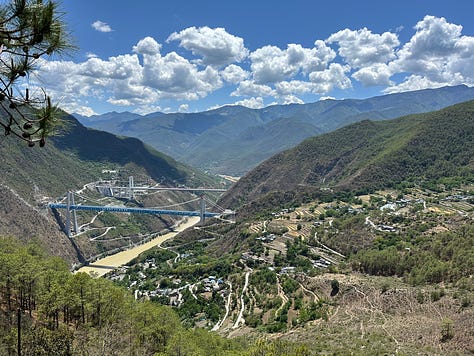
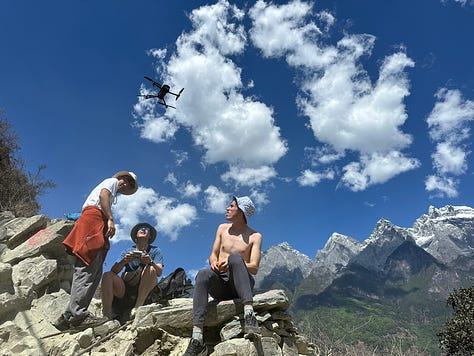
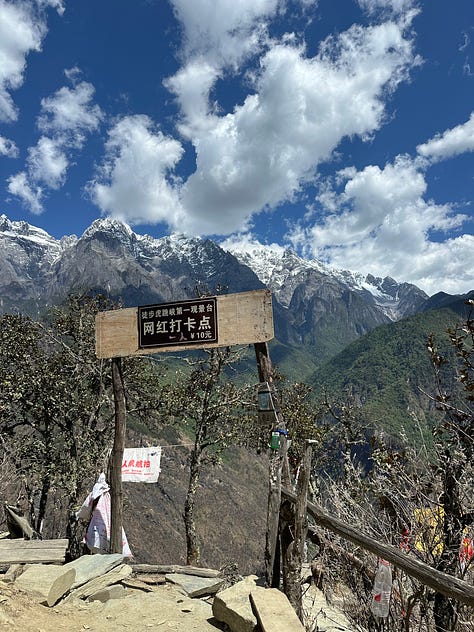
I can’t help but wonder how long Yunnan will continue to feel like a pastoral escape for tired urbanites, and more importantly, a familiar home for its local ethnic groups. The unique culture is preserved in part by its geographic distance from Beijing. But tourism is increasing, especially as the weak economy prompts more domestic travel. New high-speed rail lines now criss-cross the mountains, connecting Yunnan’s cities with neighboring provinces.
Everyone we met was absolutely welcoming to us. But if I, an outsider, felt mildly annoyed at the tourist crowds and kitschy gift shops in Lijiang Ancient Town, I can’t imagine that the Naxi people are completely unconflicted about turning their mountain farms into influencer hotspots. I don’t know how Yunnan’s linguistic diversity will fare under Mandarin education policies, or how its bountiful waterways will be impacted by new dams and bridges. Xi’s rural poverty alleviation programs have succeeded in bringing money, homes, and healthcare; but relocated entire villages along the way.
I read a recent post by
, where he warns against extrapolating macropolitical takes based on travel abroad. He writes:Hanging out in Shanghai will not allow you to see the fleet of warships encircling Taiwan, nor will you be allowed to tour the vast factories pumping out military equipment at a pace unprecedented since World War 2. Conversations with businessmen in restaurants or young people in nightclubs will not tell you much about what’s being said behind closed doors in the Politburo and the other organs of the party-state. All of the relevant decisions being made about war and peace will be made by people that you, as a tourist, will never get to meet.
I somewhat agree with him—bullshitting with aunties at the Shanghai marriage market certainly couldn’t tell me Xi Jinping’s next move. But I think Noah underrates conversation and observation as ways to understand how macro forces impact everyday people. In People’s Park, I heard about the Shanghai housing crisis, gender roles, and generational anxiety. Noah’s position is like analyzing tech by reading corporate press releases, but never test-driving the product or talking to its users. Travel can’t provide a complete picture, but it can be a catalyst for deeper understanding.
Instead, I looked toward writers like Peter Hessler. Hessler lived and worked in China for decades, so he’s no short-term tourist. But he’s also a longtime advocate of starting with ordinary people’s lives to understand China’s transformation. In the book Oracle Bones, he interweaves first-person stories of his time with various “wanderers” (e.g. migrant workers, Uighur refugees) with researched analysis of the role of history and language in Chinese nation-making. Hessler’s writing is thoughtful, endearing, and often funny. I was refreshed to see him bring grand economic narratives down to the human level; this sociological approach offered a respite from the deluge of brain-dead China takes put out by the Twitter commentariat every day.14
After all, there were so many delightful little things from my trip that I can’t figure out how to weave into this already too-long essay: morning Bund runs with my mom, baskets of perfectly ripe mangosteen and yangmei, the epic Xu Bing installation at the Museum of Art Pudong, talking to Shanghai’s vintage booksellers, and datiao dancing at the Dali Xihuahua Farm. And to be honest, I care to learn about China and its politics largely because I care about these specific people and places—and I really can’t stand when “thought leaders” conflate them with the nation-states they live in. This impulse, for me, is democratic to its core.
I still don’t know very much about China. It’s a big and complicated country, the two weeks were short, and I especially wish my language skills were better, so I could read more first-person accounts. (I’m very grateful to my family; travel squad; Bean; and our other friends, teachers, and hosts for sharing their time and answering so many questions.)
But if you’ll allow me a single provisional generalization: I was surprised by how much the China I observed embodied the myths America tells about itself. It’s a nation that moves fast and breaks things, where people rise (and fall) from poverty to riches in the blink of a generation, and where economic strength feels like its own form of nationalism.
China is also a place that’s subject to laws of physics like any other. Alongside profound change, we saw environmental damage, inequality, youth unemployment and malaise. On one hike, Saffron recalled the infamous “Four Pests Campaign,” when Mao mobilized rural communities to eradicate pests via any means possible. They hit their goals fast—too fast. The decimation of sparrows caused the number of crop-destroying insects to surge; the resulting famine killed millions before officials adjusted their approach.
Today, though, sparrows soar through the skies. Endemic species like Yunnan snub-nosed monkeys and ottelia acuminata, an edible plant that grows in Lake Erhai, have also made impressive recoveries. I didn’t get to meet the people who facilitated this restoration, but if I saw anything on my trip, it was China’s incredible human resilience—that most things that are broken can be rebuilt again.
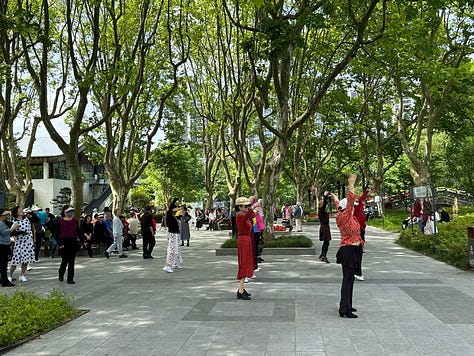
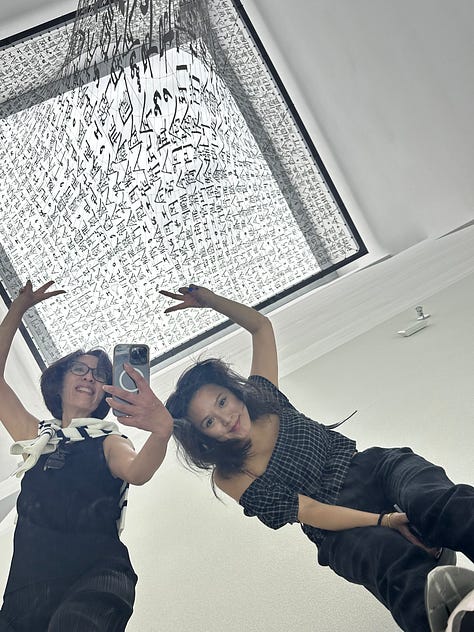
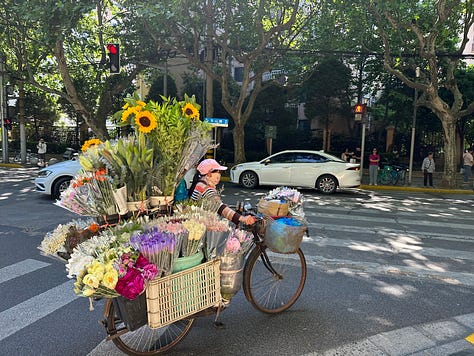
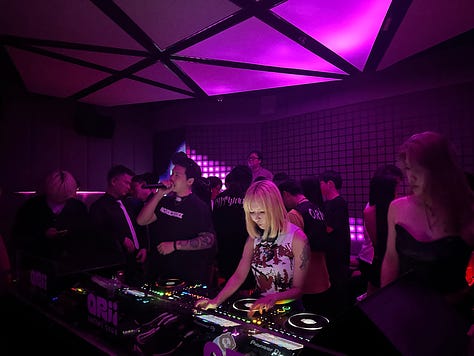
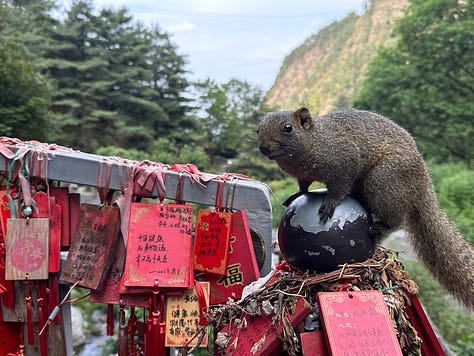
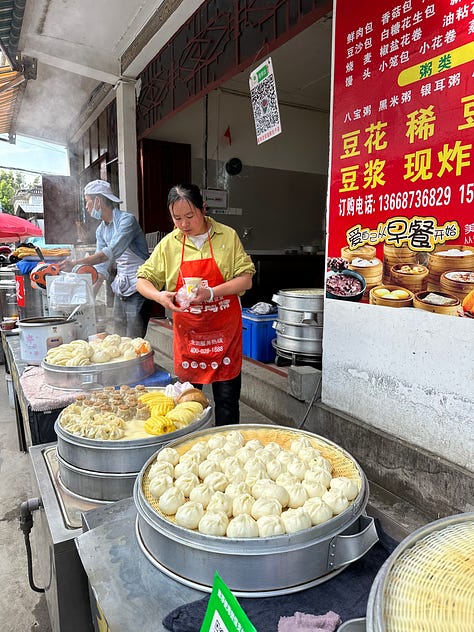
🌱 little life updates
Thank you for making it through this unusually long and meandering post. I’ve realized that my personal newsletter is much more about archiving my life than anything else, and found this difficult to edit down—there was nothing I wanted to forget.
I’ve been bad about publishing recently, mainly because work has been nuts. In April, we launched new publication themes, a bunch of podcasting features, better chat communities, and video in Notes.
Oracle Bones was by far my favorite recent read, but I’ve also recently enjoyed Emma Cline’s The Guest, Becca Rothfeld’s All Things Are Too Small, Haruki Murakami’s The Novelist as Vocation, and Ben Lerner’s The Hatred of Poetry.
Hate to become a China Guy™, but I now feel much more compelled to spend much more time in China, visit more regions, and brush up on my language skills (especially reading and writing) so I can actually navigate the super-apps and read more first-person accounts. In the interim, I’ve been hanging out in the archives of
, the podcast, , the Numb in China series, Peter Hessler’s New Yorker articles, and Sixth Tone.
If you have additional context or reading recommendations based on this update, I’d love to hear.
Warmly,
Jasmine
The Chinese American experience, including Chinatown life, has its own valuable heritage. Chinatowns in most cities are politically and economically underserved, hence the old orientalized architecture; and their communities have developed their own local cultural traditions. They are also, importantly, not China.
In addition to the linked
essay on how the West often mistakes ethnic heritage for expertise, I’m conscious of how distorted American views of China are—often divided between xenophobic hawkishness and naive, uncritical praise for state capacity. I really don’t want to contribute, so I’ve tried to stick to my own experiences and do contextual research where necessary. So please do not construe these 2.5 weeks of observation for anything resembling knowledge.It’s worth reading my friend
’s excellent essay on “wanghong urbanism” in China: the construction of cities around viral social media aesthetics.Ambitious numeric goals like these seem exceedingly common in government press releases. I think Chinese bureaucrats would make great growth PMs.
Bike sharing in Shanghai is far cheaper and more widely used than in any U.S. city I’ve been to, enabled by China’s high population density. Within the city, I never needed to take a car.
American VCs and startup bros are naturally interested in how to make these same super-apps and delivery systems work in the United States. After talking to a few analysts and using the apps myself, I’m pretty sure that this is primarily explained by China’s (a) much lower labor costs (many gig workers are migrants from rural and lower-tier cities), and (b) much higher population density / economies of scale (there are over 25 million people in Shanghai, and even “third-tier” cities tend to have over 5 million). Better logistics capabilities and close government relations also play a role. I’m not sure these factors will shift in the U.S.’s favor anytime soon, and I’m not sure they should. Do we really need delivery to be that much faster?
There are many reasons, of course, but one obvious difference is in property laws and eminent domain. In China, all land is publicly or collectively owned. Processes like “gentrification” and “displacement” are state-driven, happening quickly without real consultation or recourse (though compensation and relocation is offered). But perhaps because redevelopment happens constantly, most Chinese people don’t seem too bothered. For example, my grandparents’ old apartment was torn down several years ago as part of Hongkou’s urban renewal. They simply moved a few blocks to a high-rise nearby. There is a sense that projects (and sacrifices) like these are an inevitable part of modernizing the city.
The factory is nearest to the city of Shaoxing, which you may know from their trademark cooking wine.
Brian: “This is, like, the Chinese equivalent of those rocket-emoji-American-Dynamism guys on Twitter.”
I’ve been pleasantly surprised to discover the range and quality of the Chinese Substack ecosystem, largely thanks to
’s early adoption and advocacy. (I’m referring to English-language writing on China for international audiences; Substack is firewalled in China and only accessible via VPN. One writer told me that WeChat articles are the most popular way to blog in Chinese.)While doing supplemental reading for this blog post, one of my top sources was Sixth Tone: an English-language publication that is state-owned, but has published a lot of accessible analysis on sociopolitical issues in China. But I was sad to learn that Sixth Tone is now being neutered by an increasingly repressive government, which has punished its editors for criticizing Zero Covid, demanded more “positive stories,” and dropped them out of international journalism awards.
The Three Body Problem, TikTok, and Genshin Impact.
Yunnan food is really interesting, largely because it encompasses such broad ethnic heritage. Two bits of further reading: this piece from
on Yunnan-Thai culinary history, and this piece on xidoufen (tofu magic!) from of The Vegan Chinese Kitchen.While Hessler’s books are very popular, he hasn’t escaped controversy. He focuses on individual lives; critics asked why he didn’t discuss more politics. Hessler wanted to ensure his subjects got to read his books in Chinese; others criticized him for compromising with Chinese censors to do so (except for Oracle Bones, which was simply too sensitive). I found these debates—including the opposite perspective from his New Yorker colleague Evan Osnos—challenging and interesting.

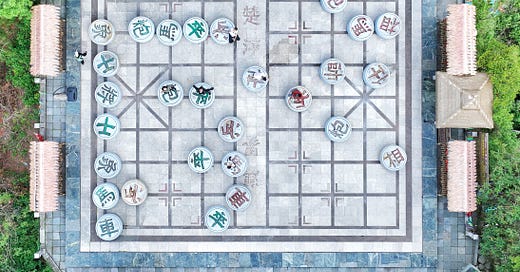


Hi Jasmine! Loved the post, recently went back to China in the summer of 2023 and my parents are from the Zhejiang region, so a lot of what you said resonated with me. I kind of felt it would as soon as you mentioned diaspora angst - I think a lot of my friends who deal with that feel like they don't "belong" to a group, but I luckily feel strongly tied to both my Chinese and American halves and pretty comfortable with both (probably thanks to having a good relationship with my parents...)
One of the things that is hardest for me to describe to my friends about China really is how much you can feel technological and economic progress as a normal citizen The rate of change is so, so fast there - when I visited my grandparents, they confessed to eating out a lot less nowadays because so many restaurants have converted to fully digital menus, and they aren't nearly as comfortable with the QR code ordering and using Alipay as people who grew up with smartphones are.
I feel like I’m a little more optimistic about the future of China's cultural output, even in the face of extremely heavy-handed government regulation. It's definitely something you feel while you're there, but I would argue that you probably shouldn't be expecting that much cultural output from China right now, anyway?
It took Korea and Japan getting rich first before they were able to really do their creative work; my understanding is that kpop’s breakout into the mainstream consciousness arose after Samsung and Hyundai and LG ate the world, and the same for anime and Japanese food and philosophy - they became smash hits after Honda and Sony et al made Japan a major player.
I feel like China is on its way - it kind of feels like the country is an uncertain adolescent teenager, that feels the need to prove itself. When the country matures and feels secure about its place on the global stage (not educated enough on the topic to speak about when it might happen or the implications of this for the rest of the world), I think/hope that's when we'll see China's creative scene come into its own.
"Instead, I looked toward writers like Peter Hessler. Hessler lived and worked in China for decades, so he’s no short-term tourist. But he’s also a longtime advocate of starting with ordinary people’s lives to understand China’s transformation."
I should point out that I did spend quite a bit of time in my post arguing that living in a place for years is very different than visiting it for a few weeks... 😉